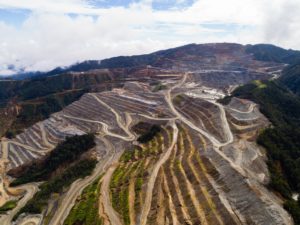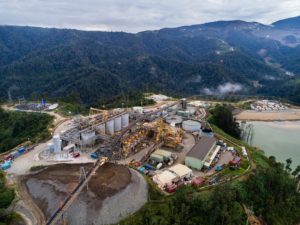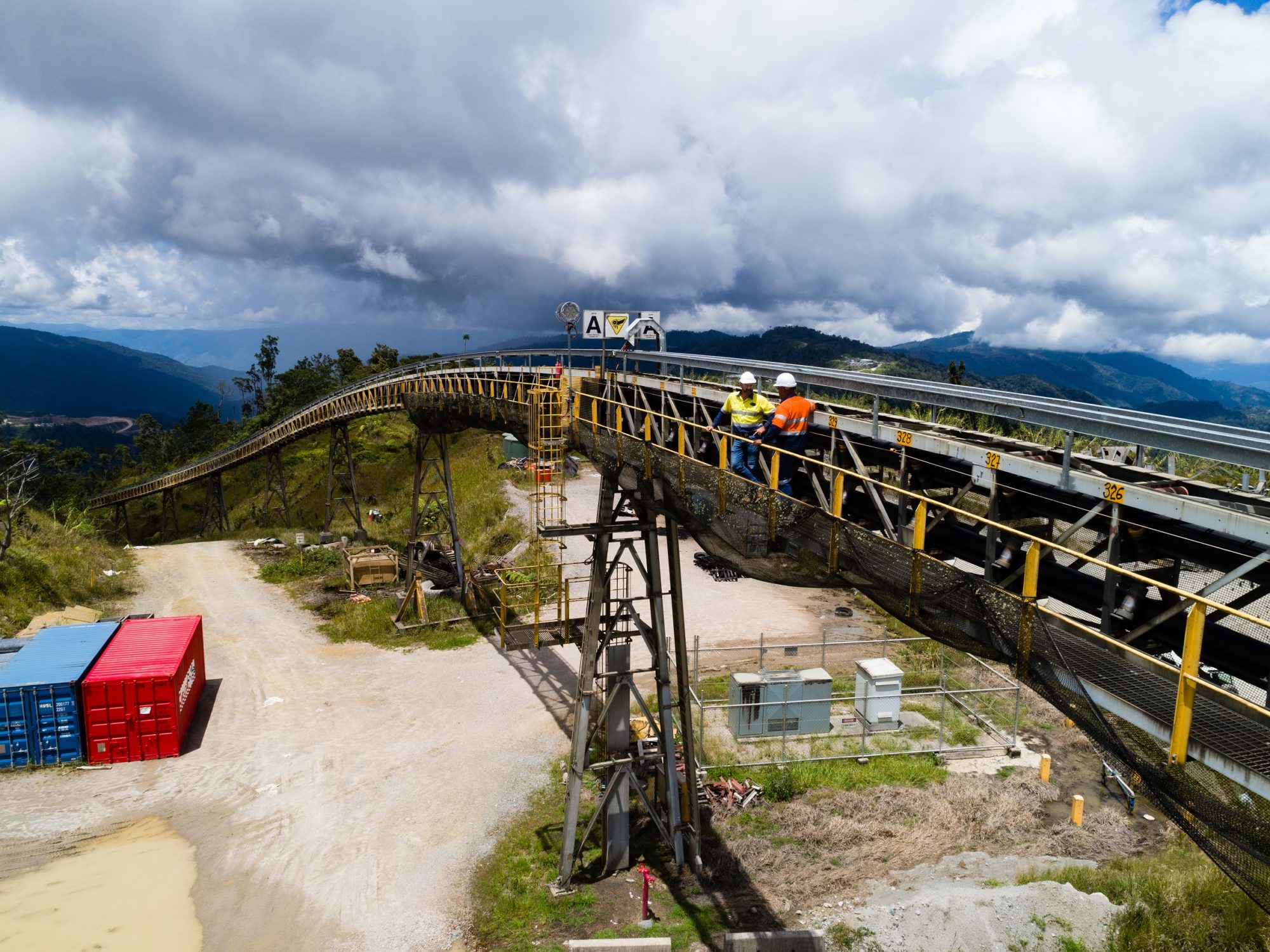Harmony Gold Mining Company Ltd was first registered in 1950 with a single mine lease and poured its first gold in 1954. Harmony is a world-class gold mining and exploration company, with operations and assets in South Africa and Papua New Guinea (PNG). Harmony has close to 70 years’ experience in the industry, and expects to have produced between 1.26 Moz and 1.3 Moz in 2020, with the final numbers set to be announced February 23.
Harmony’s assets include one open pit mine and several exploration tenements in PNG. The company also has nine underground mines, one open pit operation and some surface sources in South Africa. Additionally, in a joint venture, Harmony owns 50% of the significant Wafi-Golpu copper-gold project in PNG – a tier 1 asset.
Situated some 210 km northwest of Port Moresby, the Hidden Valley gold and silver mine is Harmony’s third largest operation. Hidden Valley is an open pit mine, located in New Guinea’s high lying Morobe Province at an altitude of around 2,500 m. The mine consists of three main lodes: Hidden Valley – Kaveroi (HVK), the two main lodes, mined as a single pit, and Hamata. The processing plant is located near the Hamata mining area.

Processing Business Unit Manager, Geoffrey Atkinson, is responsible for the mine’s processing and fixed plant maintenance. His 400 strong team maintains site services, as well as the operations – from primary crushing all the way through to processing and smelting. A veteran of the mining industry, Atkinson started his career as a tradesman fitter and has worked on all aspects of plant maintenance across Australia and New Guinea within a diverse range of commodities – gold, coal, silver, lead, zinc and uranium.
“Our mine has a target gold production of 190,000 to 200,000 ounces per annum, which was achieved last year.” he said. The Hidden Valley Kaveroi pit is located about 5km away from the processing plant which is situated adjacent to the Hamata orebody. There’s a steep and winding access road between the pit and plant that crosses the Watut River. Because of the high annual rainfall (up to 3m pa) the river is subject to short flooding events. Operating heavily laden haul trucks along this road when it is wet is certainly not the preferred means of ore transportation.
The pit is also linked to the processing plant via a 5.4 km overland pipe conveyor. ROM feed from Hidden Valley Kaveroi goes through two-stage crushing, before being transported by the conveyor onto the coarse ore stockpile at the processing plant. It then undergoes grinding, flotation, concentrated leach and CCD. Conventional gravity and CIL circuits are used for gold and a Merrill Crowe circuit for silver extraction.
“The overland conveyor is pivotal to our operations,” said Atkinson. “Our only other option is to haul from the top to the bottom, which comes at a huge cost and increased risk.”
Harmony Gold’s Executive General Manager for Engineering and Asset Management – Stan Bierschenk, is a seasoned mining professional with a background in electrical and mechanical engineering. He has been with Harmony and associated companies including African Rainbow Minerals and AngloGold since around 1986. Bierschenk is responsible for Harmony’s engineering and assets, which includes assisting with studies for future development projects in South East Asia.
“The road from the mining area up at the Hidden Valley Kaveroi orebody is very mountainous, dropping about 400 m in altitude from the Hidden Valley crushers down into the Watut Valley and then back up the other side to the plant.” said Bierschenk. “After weighing up various options, we determined that an overland conveyor was the preferred ore transportation mode. A tube or pipe conveyor was chosen because it can handle the vertical as well as horizontal changes in direction presented by the region’s topography.”
“You can put 14-15,000 t per day over the conveyor, but if you wanted to use trucks to move this amount of ore, the number of trips would be significant,” he continued. “We use the road to transport all materials, fuel, reagents and our employees to and from the mill. We only use the road for hauling, if the overland conveyor is out of service for lengthy periods and then only with consent from the Mineral Resources Authority. This would not be considered as a permanent solution, as the road would become too congested. Hauling is uneconomical and just not practical.”
The overland conveyor, known as the OLC, snakes down the mountain following its contours. But if the conveyor stops, only the coarse ore stockpile at the processing plant with a capacity of around 60,000 t keeps operations going. Once the stockpile is depleted, the processing plant grinds to a halt.
“When you are milling 14,000 tonnes a day, there is a maximum of 4.5 days of milling without the overland conveyor,” said Bierschenk. “The OLC needs to stay ahead of the mill, and hence it is the most important piece of equipment on the mine.”
“The impact of OLC downtime is most significant when it affects the running of the SAG mill, in terms of direct cost it is in the order of US$40,000 per hour or US$1 million per day” explained Atkinson. “There’s also the company risk in terms of missing our targets and damaging market perceptions.”Since the facility was originally commissioned, the OLC was hampered by operational issues that led to unexpected downtime and increased maintenance expenditure.“We were experiencing longitudinal cracks on the pulley side of the belt. Once that happens and you get water ingress, you lose adhesion between the steel cords and the rubber. We were only getting a three-year belt life when we expected five.” said Bierschenk. “Although the risk was not to the integrity or failure of the OLC, it was impacting the conveyor’s availability and utilisation.”
Between 2018 and 2019, Metso (now Metso Outotec as of July 1, 2020) worked with the Harmony Gold team to resolve the OLC’s operational issues, significantly improving conveyor availability. “After discussing different belt options with Metso, rather than just replacing the belt with a slightly thicker one, we thought we should understand the impact of such a change on the conveyor. We engaged consultants to help us review the engineering of the entire conveyor system to see if the drives, structures braking, and other critical components could handle a heavier belt. In consultation with Metso, they confirmed that the system could in fact handle the heavier belt, which is how we arrived at the belt we have at the moment.” said Bierschenk.
“Once we had decided on the belt construction, and where it would be manufactured, we sent a consultant to Metso’s production facility to conduct a rigorous assessment of its quality and controls. This ultimately resulted in the delivery of a belt that will give us a five-year life span.” The project was tackled in two parts: improving the engineering of the belt and implementing a solution for less frequent and safer belt change-outs.
Phase 1: Belt engineering
The conveyor is unusual as it utilises pipe belt technology. The belt opens to receive feed and then curls to form a pipe to convey the material before opening to discharge. The belt on Hidden Valley’s OLC was sometimes twisting preventing it from opening and closing, as well as ‘pulling out’ of its guide rollers. When this happened, it would result in prolonged downtime, causing potential production losses.Metso engineering staff used their experience, knowledge and engineering know-how to develop a new belt that’s rigid enough to resist twisting but flexible enough to form a pipe. Metso designed the belt construction, then oversaw its manufacture and delivery to site.“I was really impressed with the first X-ray of the belt,” said Atkinson. “it really opened my eyes to the quality of the work that was done.”
Phase 2: Turnkey solution for belt change-outs
Previously, belt change-outs were limited to sections of 800 m for each 5-day (120 h) shutdown. The limitations on the length of belt to be installed meant that either longer or more frequent shutdowns were required when more than 800 m needed changing, increasing cost and HSE exposure, as well as reducing productivity. “Once we had a thicker and stiffer belt, the question that we asked ourselves was – How can we change our systems so that we can replace a greater length of belt in a 5-day shutdown?” said Bierschenk. “Because we have 10.8 km of total belt length and were only getting a 3-year lifespan, we were changing 800m sections far too often – and we can’t really afford the downtime,” he continued. “Our two conveyor belt specialists had previously worked on operations where ‘belt-flaking’ was used to change-out longer sections of belt, so I asked Metso and GHD to assist in the design of a new splicing station. With Metso’s help, we were able to develop a system that allows us to change out 3.5 km or more of belt at a time.” Metso delivered a turnkey solution with a completely different philosophy to belt changeouts. The project started with the development of a change-out methodology and engineering assessment. This was followed by belt change-out equipment design and engineering certification, then manufacture and transport to site. Metso conducted on-site installation and commissioning providing service technicians as required.
Staff benefits from outside engagement
Harmony Gold has a strong policy of local workforce inclusion. Around 96% of Hidden Valley’s more than 1,200 staff come from local communities – so training and development is a major focus of the operation. “Many of the locals have never worked in a mine before, so our training teams help them to reach a capable level,” said Atkinson. “It’s all about supporting sustainability in the local community.”
Mechanical foreman and conveyor maintenance specialist – Robin Mali, described the Metso engagement as an opportunity to learn and improve skills. “Getting experienced staff from Metso to come here was also beneficial in relation to how much we could learn from them about the conveyor and how to maintain it,” he said.

Prior to the new belt and change-out methodology, the 3-month average availability for the OLC was 75.9%. Since the upgrade, this has improved to 95.1% – an increase of 19.2%. “Previously, to change out 3.2 km of belt would have taken a total of 20 days, doing 800 m at a time.” said Bierschenk. “Now we can do it in a single 5-day shutdown, which means that we have reduced belt change-out time by 15 days per year.”
Metso’s pinch drive and the belt flaking change out system reduced four 5-day shutdowns to one. With the high direct cost of shutdowns, the project delivered a significant maintenance cost saving. According to Bierschenk, these savings are eclipsed by the gains in production delivered through better OLC availability. “At around $1 million in gold production per day, that means we would have increased annual production value by around $15 million through this improvement alone.”
“The safety of our people is the most important focus area in our business. Maintenance of any kind has inherent hazards,” explained Bierschenk. “With belt change-outs you’ve got moving parts, and work that is physical and potentially dangerous for the 20-30 people involved. Anything we can do to reduce maintenance time also reduces the exposure of our people to hazards.”
“A belt change-out is a difficult job – it is very physically demanding and stressful,” said Mali, “Doing the change-outs only once a year is a great safety improvement.”
Bierschenk and Atkinson feel very positive towards the services provided by Metso. “It’s certainly one of the best relationships I’ve seen between staff and contractors on a site,” said Bierschenk. “With the whole team from Metso that have come to site at various times, it has always been positive, constructive and engaging. Everyone worked towards the success of the project. The focus on detail was the key. From the very beginning, the amount of detail and effort that went into creating something that would work – from the proposal through to the design, the project management, belt flaking and pulling in of over 3,200m – I believe that contributed to the success of this project.”
Harmony Gold has plans for further OLC improvement. “We would like to get the belt up to its nameplate throughput of 800 t per hour which would be a major benefit, should we ever decide to extend the life of the mine,” said Bierschenk. “One of the reasons we need higher throughput, is to deliver more tonnes to the plant than what is milled, thus providing a buffer to ensure that we can achieve our targets. To achieve these goals, I’ve no doubt we will be engaging Metso again.”











